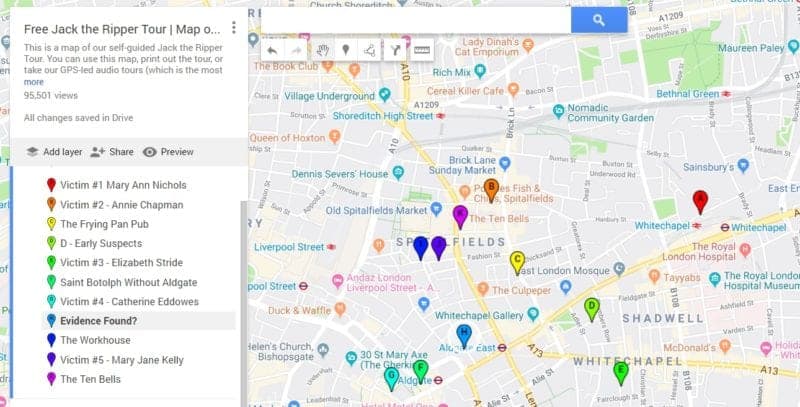This is a free self-guided Jack the Ripper walking tour along with a map of important locales in the case of these unsolved murders.
As one of Free Tours By Foot's London tour guides, I am very familiar with this infamous case. I've put together this guide for you to use to see for yourself the sites related to the Jack the Ripper's dastardly deeds.
For a fuller understanding of the case and the sites, you might like to try our free GPS-led audio tour.
The audio tour has highly detailed descriptions of crime scenes and horrific slayings by an unidentified assailant known as... Jack the Ripper.
Here's a sample.
Want to hear the tale in person? Join us on our guided Jack the Ripper Tour!
Self-Guided Jack The Ripper Walking Tour
Throughout this walk, we will discuss the unsolved, brutal murders of five East End prostitutes.
Tour Length:
- 3 miles - just under 5 km
- Approximately 2.5 hours, depending on your walking pace
NOTE: For guests with mobility issues, or those with prams or buggies, there are no steps on the route, but there are cobbled streets to take into consideration.
This self-guided Jack the Ripper Walking Tour begins near Whitechapel Underground Station.
If you are unfamiliar with using the Underground ("Tube") check out our guide to navigating the Tube.
Click the map to enlarge or to use on a smartphone.
A - Victim #1 Mary Ann Nicholls
Exit Whitechapel Station and turn LEFT. The road dead-ends on Durward Street where you should take a RIGHT.
Walk to the old school building - the large brick building - ahead, if possible. If construction prevents you from getting there, simply stand as close as you can.
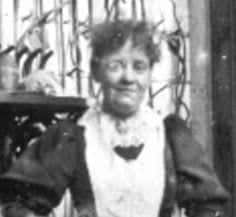
Our story begins on the 31st of August 1888. The ‘Autumn of Terror’ is about to begin when the first victim of the canonical five is murdered right here: Mary Ann Nicholls.
Mary left the Frying Pan Pub around half past midnight. She was found at 3:40 am.
The Police Constable sees that her throat has been violently slit - from left to right, twice over, with the incision going all the way through to her vertebrae.
Detective Chief Inspector Frederick Aberline is called to work on the case and he is determined to bring Mary’s killer to justice.
But Frederick finds there is nobody with a bad word to say against Mary Ann Nichols. With no idea of a perpetrator or motive, an entire week passes with no progress on finding her killer.
Seven nights after the murder of Mary Ann Nicholls, Jack the Ripper would strike again.
B - Victim #2 - Annie Chapman
Backtrack along Durward Street until you get to Vallance Road and turn RIGHT. Take the first LEFT onto Old Montague Street and an immediate RIGHT onto Hanbury Street. Continue on Hanbury Street.
As you walk you will pass Deal Street and Spital Street, and you will cross Brick Lane until you reach a car park on the RIGHT-hand side - opposite 28 or 32 Hanbury Street.
The house where Jack the Ripper’s second victim, Annie Chapman, was murdered, no longer stands.
But it would have looked similar to the houses you see across the street, such as Numbers 28 and 32.
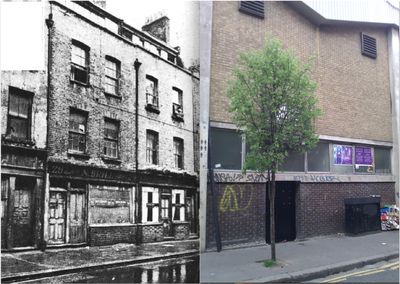
A small space off the street that offered a little privacy made the back gardens of Hanbury Street, a popular location for prostitutes to take their clients.
At 5:40 am, a man living above 29 Hanbury St came downstairs and into the back courtyard where he discovered the body of Annie Chapman.
She was slumped against the fence with her throat slashed and her body cut open from her groin to her chest, nearly cut into two.
C - Frying Pan Public House - Where Mary Nicholls Was Last Seen Alive
Continue down Hanbury Street and turn LEFT onto Wilkes St.
Take the second LEFT onto Fournier Street, lined with original 18th-century homes, giving you an idea of how the buildings in this neighbourhood appeared in the 1880s.
Take a RIGHT onto Brick Lane and walk down. Stop when you get to the decorative archway that spans the road.
When under the arch, turn around to face where you just walked from and take a look at the Shaad Restaurant.
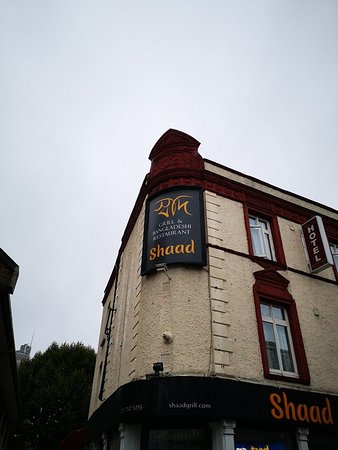
The Shaad Restaurant is the site of the former Frying Pan Pub. The two crossed frying pans carved into the stone are the original decoration of this 19th-century pub.
This is the pub where Mary Nicholls drank away her money on the 30th of August, 1888.
She is reported to have stumbled out of the pub around half past midnight and was seen by her friend just around the corner a few minutes later.
Somewhere between where you stand now and where our tour began, Mary would run into Jack the Ripper and her life would come to an end.
D - Early Suspects Kosminski and John Pizer - Mulberry Street / Zion Square
Continue down Brick Lane. When you get to Whitechapel Road, cross the street and enter Altab Ali Park.
Walk diagonally to your LEFT, through the park and exit the park onto Alder Street. Go RIGHT and immediately turn LEFT onto Mulberry Street. Stop at the middle of the buildings on the right.
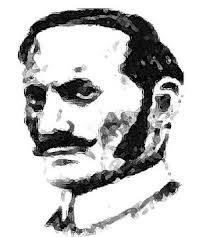
None of the original buildings from the Victorian era still stand here, but in the 1880s there was a square of houses here, which housed mostly Jewish immigrants.
This densely populated area was home to two suspects in the Jack the Ripper murder investigations: Aaron Kosminski and John Pizer.
John Pizer had a prior conviction for a stabbing offense and was suspected of a string of assaults on local prostitutes.
He was arrested after the Ripper’s first two murders but was cleared as there was no concrete evidence against him, and he had strong alibis for the nights the murders were committed.
Kosminski was known to be mentally unstable, having previously threatened multiple women with knives.
In memoirs published in 1910, Assistant Commissioner Sir Robert Anderson also names Kosminski as his prime suspect.
His reasoning was that he believed Jack the Ripper was a local Jewish man of low class and Kosminski was known to be mentally unstable, having previously threatened multiple women with knives.
Anderson also claimed that the identity of the Ripper was known by one person who wasn’t willing to testify as they were also Jewish and didn’t wish to turn over a fellow Jew to the police.
E - Victim #3 - Elizabeth Stride - Henriques Street
Continue down Mulberry Street and take a RIGHT onto Plumber’s Row. And the end of the road, turn RIGHT onto Coke Street and take the first LEFT onto Weyhill Road.
When that road ends, turn LEFT onto Commercial Road and take the first RIGHT onto Henriques Street, formerly known as Berner Street. Walk along until you come to the Bernhard Baron Building on your LEFT.
You are standing now where Jack the Ripper’s third victim would meet her untimely end.
Elizabeth Stride was the Ripper’s only non-English victim.
She had moved to London at the age of 22 and married a local man. It appears that she took up prostitution again, part-time, after the collapse of her marriage.
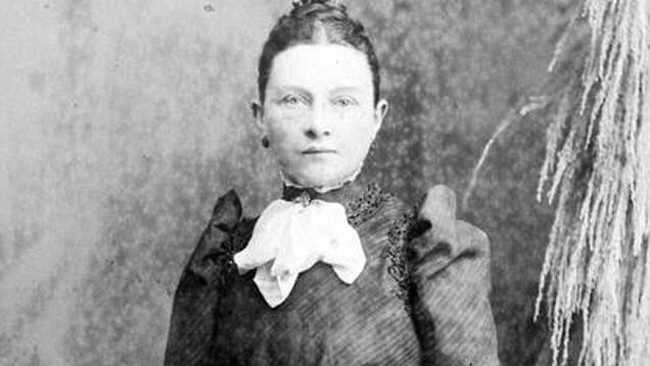
In the early hours of the 30th of September, a man's horse shied away from the movement in the dark street. After the man returned to the scene with his lantern, he found the body of Elizabeth Stride.
It is believed that the Ripper was interrupted, and the man's retreat to the pub to pick up his lantern gave the culprit enough time to flee the area.
But Jack the Ripper was not yet done for the night.
F - St. Botolph-Without-Aldgate
Retrace your steps to Commercial Street and take a LEFT. Follow the road until it dead-ends then take a LEFT onto busy Whitechapel Street.
Pass Aldgate Station, then Aldgate East Station, until you get to the church of St. Botolph-Without-Aldgate Church. This is your next stop.
Prostitution was illegal. However, since the police understood prostitution was the women's only means of survival, there were two rules for area prostitutes.
First, prostitutes could not loiter or stay in a single place for a long time - they had to always keep moving.
Second, the women were not allowed to approach customers, the customers had to approach them.
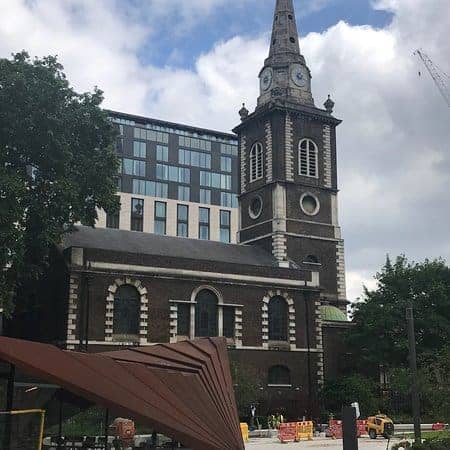
Providing the women followed these rules, the police would turn a blind eye. For this reason, up to 200 prostitutes a night continuously walked in circles around this church, waiting for clients.
Jack the Ripper’s fourth victim was last seen alive circling this building.
G - Victim #4 - Catherine Eddowes
On your RIGHT are some interesting pictures and information about the history of the Whitechapel area, which may help give you a visual reference to how this area looked during the time these murders took place.
After viewing those, turn LEFT and walk between the buildings until the space opens into Mitre Square.
The proximity of this location to St. Botolph’s Church leads us to believe that after being interrupted during his slaying of Elizabeth Stride, Jack the Ripper headed straight to the prostitutes' church to pick up his next victim, Catherine Eddowes.
An eye-witness report puts Catherine at the entrance of this alleyway at 1:35 am, in conversation with a man.
The PC on duty the night of Catherine’s murder passed by at 1:45 am, finding her mutilated body at the bottom of this passage in the darkest corner of Mitre Square.
The state of her body and a missing organ after less than 15 minutes suggested a rage and fury that had not yet been seen in the Ripper case.
Walk to the end of Mitre Square and pause when you get to the gates on your LEFT. Just through the gates is a tree - this is the approximate location where Catherine Eddowe’s body was found.
H - Evidence - Graffiti and Apron Found
Now, turn RIGHT onto Mitre Street. Take the first RIGHT onto Creechurch Lane which you should then follow along until it turns into Stoney Lane as you walk across Houndsditch Road.
Walk ahead until you come to White Kennett Street where you will make a RIGHT. Take the first LEFT onto Gravel Lane and walk until the lane stops at Middlesex Street.
Take a LEFT then an immediate RIGHT onto New Goulston Street. Walk until the Street Ends at Goulston Street.
Across the street stands the Wentworth Model Dwellings. Take a look at the doorway between numbers 40/41.
An hour after Catherine Eddowe’s body was found in Mitre Square, PC Alfred Long stumbled across a bloody piece of cloth taken from Catherine’s apron, stuck to the doorway.
And written in red chalk: ‘The Juwes [original spelling] are the Men that will not be blamed for nothing.’ This is one of the only clues discovered during the period Jack the Ripper was active.
The bloody pattern of the knife blade on the apron appeared to belong to a type of knife used in surgical amputations.
So at the very least, this suggested to the police that Jack the Ripper had access to surgical weapons.
I - The Workhouse
With New Goulston Street at your back, turn LEFT onto Goulston Street. Keep walking and Goulston Street turns into Bell Lane.
Keep following until you see Frying Pan Alley on your LEFT. Just past this, still on Bell Street is the old workhouse.
You’ll notice two entrances here, separate doorways for men and women.
On a typical day, you would have around 200 women and children queuing up for a place in the house and a similar number of men on their side. The dormitories themselves only slept 200 in coffin-shaped boxes.
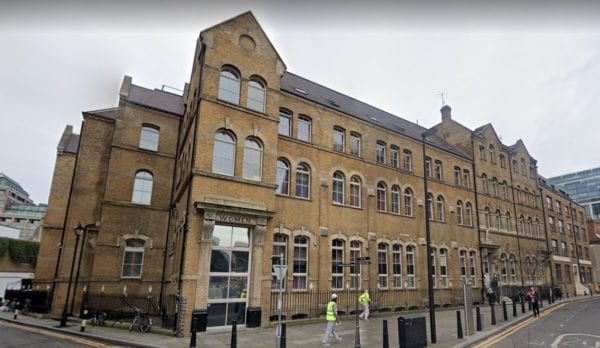
If a person arrived when all the beds had been allocated, they would be given a rope attached to the wall and would have to sleep upright against the rope.
These workhouses were horrendous places to be. And the price for all of this? A 16-hour shift of manual labour.
Today this building serves as a student accommodation for the London School of Economics - and are hopefully a bit more comfortable today than they were just over a century ago.
J - Victim #5 - Mary Jane Kelly
With the Workhouse to your back, look across the street to the modern building directly opposite you.
This building sits on the site of what used to be Dorset Street, and the location of Jack the Ripper’s final slaying.

In the 19th century, Dorset Street was considered to be the most dangerous Street in London - and some said even the entire country.
A person walking down that street in the 1880s would be unlikely to make it all the way down retaining all their possessions.
This is the murder site of the Ripper’s final victim: Mary Jane Kelly, who lived at 13 Millers Court here on Dorset Street.
A 24-year-old Irish girl, Kelly was to be the last of Jack the Ripper’s known victims.
Her murder was so brutal and the desecration of her corpse so barbaric that the only way she could be identified was by the clothing she had been wearing the night before.
Why? Hers was the first of the Ripper’s murders to take place indoors. Without having to constantly look over his shoulder to avoid detection, the murderer had all the time in the world.
And this horrific scene provided the imagery of the first-ever crime scene photograph.
K - End of The Line
From here, we will walk to the location where Jack the Ripper would have emerged from Dorset Street all those years ago.
With the workhouse behind you, take the street that is slightly to the right and ahead of you, White’s Row.
Walk until you get to the corner of Toynbee Street and then turn LEFT. Walk until you get to the corner of Brushfield Street.
Jack the Ripper would have walked out of Mary Jane Kelly’s room, headed down Dorset Street and onto the road we are standing on here.
And what would he have seen? Nearly exactly what you are seeing right now: St. Christ’s Church Spitalfields, Spitalfields Market, and the Ten Bells Pub.
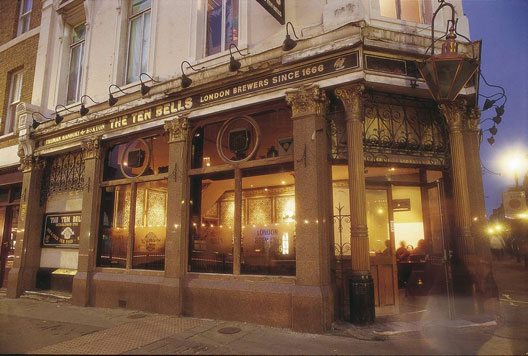
All five of his victims were known drinkers at the Ten Bells. It is the belief of investigators both at the time and now that whoever Jack the Ripper was, it’s incredibly likely he was a regular at the Ten Bells.
Suspects
Now cross the street to Christ’s Church and stand nearby, surveying the buildings here and the unchanged streets surrounding you as we pause to consider who the Jack the Ripper may have been.
There have been over 300 suspects in the Jack the Ripper murder investigations. For brevity’s sake, we will take you down a few of the top suspects.
- Aaron Kominsky, a known misogynist previously mentioned
- Montague Druitt, a school teacher and banker who fit the physical description of Jack the Ripper
- Walter Sickertt, a well-known impressionist artist with an interest in Jack the Ripper
- Prince Albert Victor, Queen Victoria’s eldest son has a rumored child with a Whitechapel prostitute
- Dr. Frances Tumbledy, an American quack doctor from upstate New York and a known misogynist
There are dozens more, and even suggestions of a JANE the Ripper, rather than a Jack.
But each theory has its supporters and detractors and the reality of the situation is that it’s highly unlikely the killer’s identity will ever be positively known.
Aftermath and Conclusion
It is worth mentioning that the Ripper killings had long-lasting and far-reaching positive ramifications for the people of the East End. This now-legendary story was the first tabloid murder sensation!
With all this attention on Whitechapel, people worldwide were wondering why, in the richest and largest city on earth, were their own people living in these conditions.
Massive social reform came about as a result of the murders with new charities and actions by The Good Samaritans and the Church of England to end child homelessness and help the poor.
If you’ve enjoyed your Jack the Ripper Tour with us, take a look at our other self-guided tours:
- City of London
- Royal London
- Harry Potter
We also offer pay-what-you-like walking tours on a daily basis here in London and we’d love to have you join us - simply book online.
RELATED POSTS:







